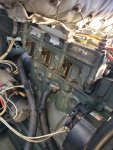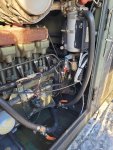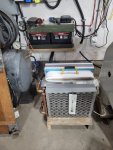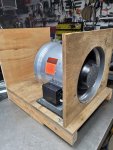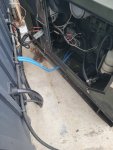- 79
- 164
- 33
- Location
- Hampton, NH
Sounds like you have a handle on the application side. I agree with you regarding the heat exchanger. I am always amazed at how efficient they are. In our power plant we had scores of heat exchangers. Some were condensers and some were used in the plants HVAC and processing. I wish I knew then what I know now when I was playing with the little marine Onan. Not to mention, the equipment needed such as aquastats and sensors are much easier to integrate into a system now. I'm retired now but if I was still working at the plant, I would have a wealth of knowledge and equipment that would have made my project actually doable. Not to mention the miracle of PEX tubing. I am really looking forward to seeing how you design and implement that design. Not sure how much I can help but I can give you what little advise I can from my own practical experience.About 30 years ago our neighbor had a small wood boiler that was a section of large steel gas line maybe 2’ in diameter and 4’ deep with a rectangular water tank welded on the top. A friend of her husbands built it and her husband connected it to the main radiator loop in the house and had issues with the radiator loop not getting much more than “luke warm” (100F or so). I looked it over and came up with a good solution for them. I connected the small wood boiler to her oil fired boiler with a pump that ran as soon as the aquastat in the well of the wood stove tank exceeded 160F. I then connected a pipe mounted aquastat to that separate loop between the oil fired boiler and the wood stove so if the loop temperature got above 190 on the return from the oil boiler to the wood stove, the pipe mounted aquastat would parallel the upstairs thermostat and force the main zone on as a call for heat until the loop temperature dropped to 180. We used the mass of the cast iron oil fired boiler as a thermal battery. The oil fired boiler also had a tankless hot water coil so it would provide all the domestic hot water they needed. It did have an anti scald thermostatic mixing valve on the domestic hot water supply so scald issues from hot water was not an issue. With the wood stove running, the main loop would cycle on for about 5 minutes and then off for about 4 minutes. If the temperature in the house was below the thermostat setting, the zone circulator would turn on and call for heat, but would not fire the oil boiler until the system water temperature cooled down below 160. It did take some trial and error to get the aquastats set where everything worked smooth. This system worked well for about 10 years until the home was flooded and they installed a coal/pellet stove upstairs where systems wouldn’t flood.
My plan is to connect the generator outside, about 15’ away from the house for noise, exhaust, and general safety. Run a dedicated small circulation pump from the convenience outlet power (internally, not plugged in) using insulated 3/4” oxygen barrier PEX to an indoor located heat exchanger so I won’t need glycol throughout my house system. I am also planning to add a large buffer tank in my primary boiler loop and configure the system so I will not overcool the engine coolant, but also allow for the existing radiator and engine thermostat to dump excessive heat if my pump fails or it is a summer and I only need enough to heat up the buffer tank and our indirect fired water heater. At that point it is good to dump the heat outside.
We primarily heat our 3,000 sq ft log home with two 12,000 BTU minisplits, (which actually provide up to 20,000 btu of heat each until we are around -10F. We only need about 30,000 btu of heat to maintain the temperature in the house when the outside temps are 0 to -10 F. When the power is off or the outside temperature drops below -10 for an extended time, we switch on the propane boiler. We have multiple radiant floor zones and while running the propane boiler at 180F, the insulated concrete basement floor has a max water temperature setpoint of 100F if the outside temperature drops to -20F.
I have a 30 kWh rack mount lithium iron phosphate battery bank connected to a 12 kw split phase 120/240v inverter. Which easily runs the entire house for 24 hours. Eventually I will add some solar, but for now my plan is to run the generator using two 5 kilowatt chargeverters (240VAC to 57 VDC 5 kw rectifiers) to recharge the battery bank while running house loads. I figure this way I can easily load the generator with a nice fixed 8 or 9 kw load when running, prevent wet stacking, maximize power use while running and the heat produced by the engine. There are definite challenges to make the heating system play well with the waste heat from the generator. I figure if the power is off for an extended time, I really want to take advantage of the waste heat. Just connecting in a fan coil unit like a heater in a car with an aquastat and thermostat on the fan so the fan doesn’t run unless the water temp is above 160 and the room temperature isn’t above the setpoint would be a good application. It is nice to be able to share ideas with like minded people, I am really enjoying all the discussions here and the wealth of knowledge everyone is willing to share.
My wife is also a saint for putting up with my experiments. She actually really likes our “new” 2003 (2014 reset) MEP-803A that has 6 hours on it now.
When I first started at the plant, we had 6 Caterpillar diesel generators. 4 of them were 750KW D399's and 2 were 500KW D398's. They were plumbed into a low pressure steam boiler. The engines shared the boiler water kept at 212 degrees. The exhaust ran through the boilers (fire tube) and we actually got 90% of our low pressure steam that way. No water pumps on the Cats. They were ebulliently cooled so the engines were always at 212 degrees. Made for some interesting maintenance.
Later we installed a 5MW Solar gas turbine which made both high and low pressure steam. We even had a dual fuel 2MW Fairbanks Morse OP engine but that was a prototype that never panned out. That was replaced with a 3MW Solar turbine and the cats were sold.



